UWS Palliative Care: Psychosocial Issues and Management Report
VerifiedAdded on 2022/11/13
|10
|2871
|449
Report
AI Summary
This report delves into the critical psychosocial issues experienced by patients nearing the end of life, acknowledging the diverse emotional and psychological challenges they face alongside physical symptoms. It explores the significance of addressing these psychosocial needs within palliative care, emphasizing the impact of fear, anxiety, and loss on patients and their families. The report critically reviews various palliative management strategies, including psychoeducation, psychotherapy, cognitive behavioral therapy (CBT), and supportive interventions. It highlights the importance of a holistic approach, the efficacy of different interventions, and the role of family involvement in providing comprehensive care. The report also discusses the limitations of certain interventions, the need for further research, and the significance of tailored interventions to meet individual patient needs. The conclusion underscores the value of addressing psychosocial issues, which are essential for improving the quality of life for individuals with terminal illnesses.
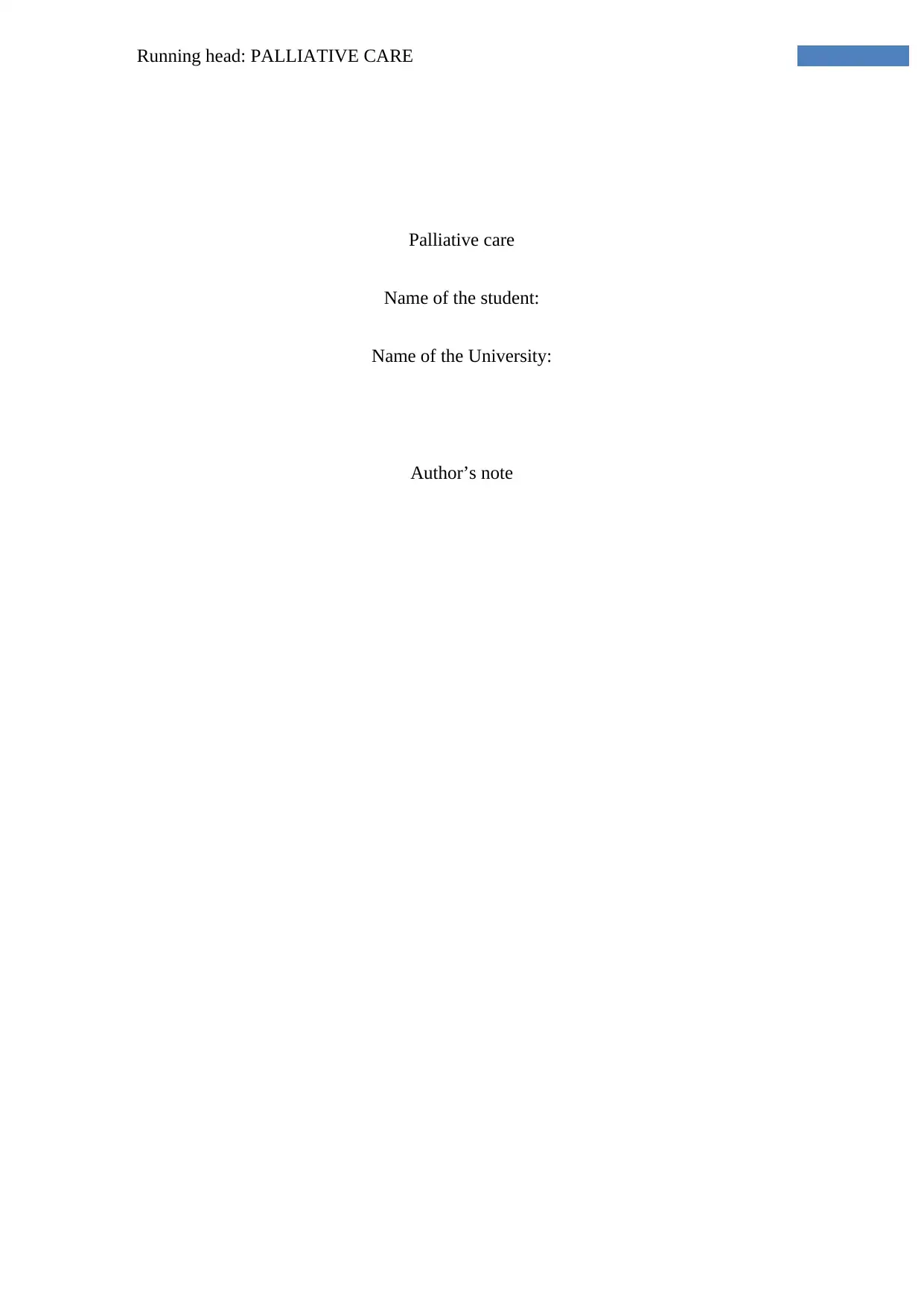
Running head: PALLIATIVE CARE
Palliative care
Name of the student:
Name of the University:
Author’s note
Palliative care
Name of the student:
Name of the University:
Author’s note
Paraphrase This Document
Need a fresh take? Get an instant paraphrase of this document with our AI Paraphraser
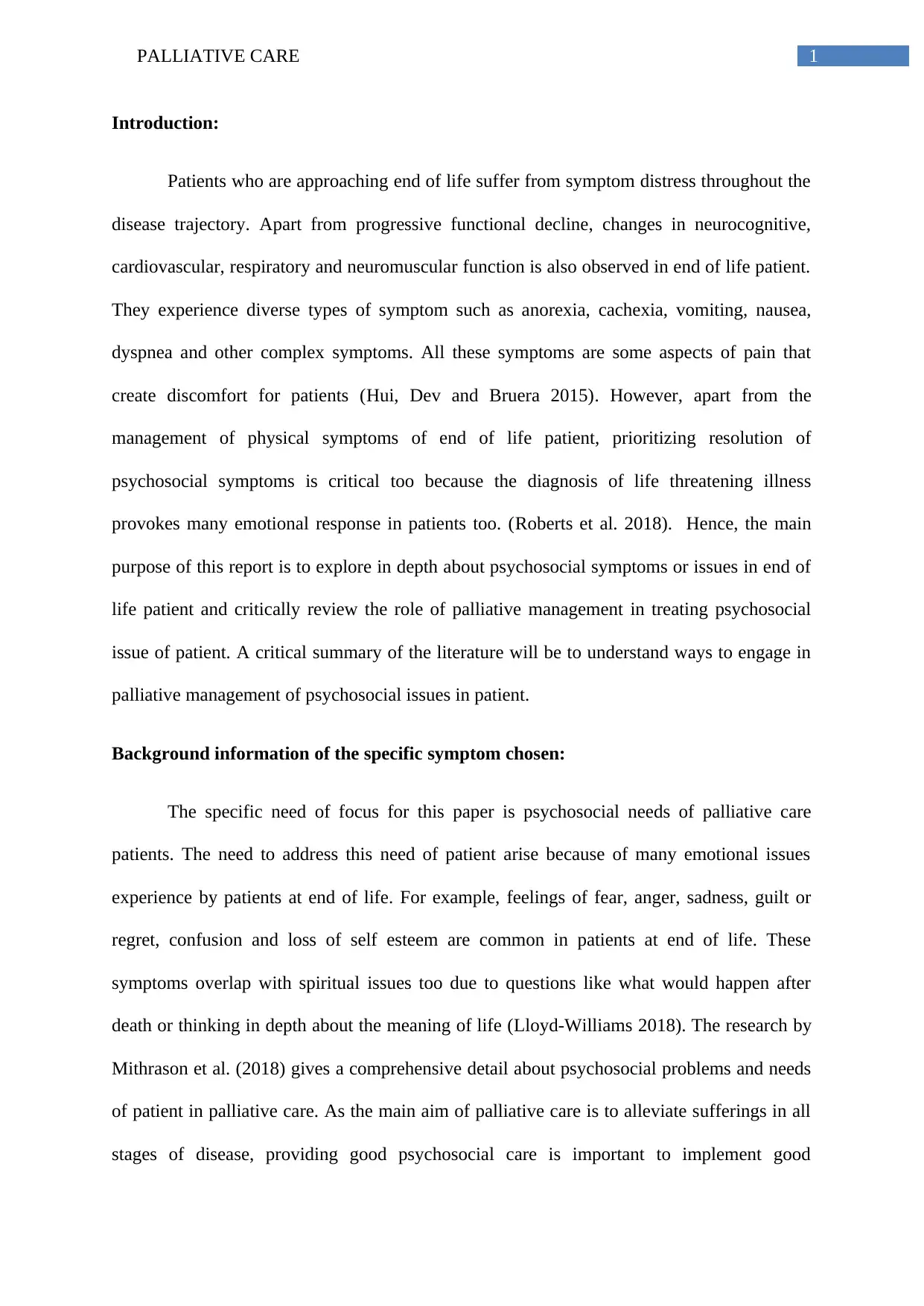
1PALLIATIVE CARE
Introduction:
Patients who are approaching end of life suffer from symptom distress throughout the
disease trajectory. Apart from progressive functional decline, changes in neurocognitive,
cardiovascular, respiratory and neuromuscular function is also observed in end of life patient.
They experience diverse types of symptom such as anorexia, cachexia, vomiting, nausea,
dyspnea and other complex symptoms. All these symptoms are some aspects of pain that
create discomfort for patients (Hui, Dev and Bruera 2015). However, apart from the
management of physical symptoms of end of life patient, prioritizing resolution of
psychosocial symptoms is critical too because the diagnosis of life threatening illness
provokes many emotional response in patients too. (Roberts et al. 2018). Hence, the main
purpose of this report is to explore in depth about psychosocial symptoms or issues in end of
life patient and critically review the role of palliative management in treating psychosocial
issue of patient. A critical summary of the literature will be to understand ways to engage in
palliative management of psychosocial issues in patient.
Background information of the specific symptom chosen:
The specific need of focus for this paper is psychosocial needs of palliative care
patients. The need to address this need of patient arise because of many emotional issues
experience by patients at end of life. For example, feelings of fear, anger, sadness, guilt or
regret, confusion and loss of self esteem are common in patients at end of life. These
symptoms overlap with spiritual issues too due to questions like what would happen after
death or thinking in depth about the meaning of life (Lloyd-Williams 2018). The research by
Mithrason et al. (2018) gives a comprehensive detail about psychosocial problems and needs
of patient in palliative care. As the main aim of palliative care is to alleviate sufferings in all
stages of disease, providing good psychosocial care is important to implement good
Introduction:
Patients who are approaching end of life suffer from symptom distress throughout the
disease trajectory. Apart from progressive functional decline, changes in neurocognitive,
cardiovascular, respiratory and neuromuscular function is also observed in end of life patient.
They experience diverse types of symptom such as anorexia, cachexia, vomiting, nausea,
dyspnea and other complex symptoms. All these symptoms are some aspects of pain that
create discomfort for patients (Hui, Dev and Bruera 2015). However, apart from the
management of physical symptoms of end of life patient, prioritizing resolution of
psychosocial symptoms is critical too because the diagnosis of life threatening illness
provokes many emotional response in patients too. (Roberts et al. 2018). Hence, the main
purpose of this report is to explore in depth about psychosocial symptoms or issues in end of
life patient and critically review the role of palliative management in treating psychosocial
issue of patient. A critical summary of the literature will be to understand ways to engage in
palliative management of psychosocial issues in patient.
Background information of the specific symptom chosen:
The specific need of focus for this paper is psychosocial needs of palliative care
patients. The need to address this need of patient arise because of many emotional issues
experience by patients at end of life. For example, feelings of fear, anger, sadness, guilt or
regret, confusion and loss of self esteem are common in patients at end of life. These
symptoms overlap with spiritual issues too due to questions like what would happen after
death or thinking in depth about the meaning of life (Lloyd-Williams 2018). The research by
Mithrason et al. (2018) gives a comprehensive detail about psychosocial problems and needs
of patient in palliative care. As the main aim of palliative care is to alleviate sufferings in all
stages of disease, providing good psychosocial care is important to implement good
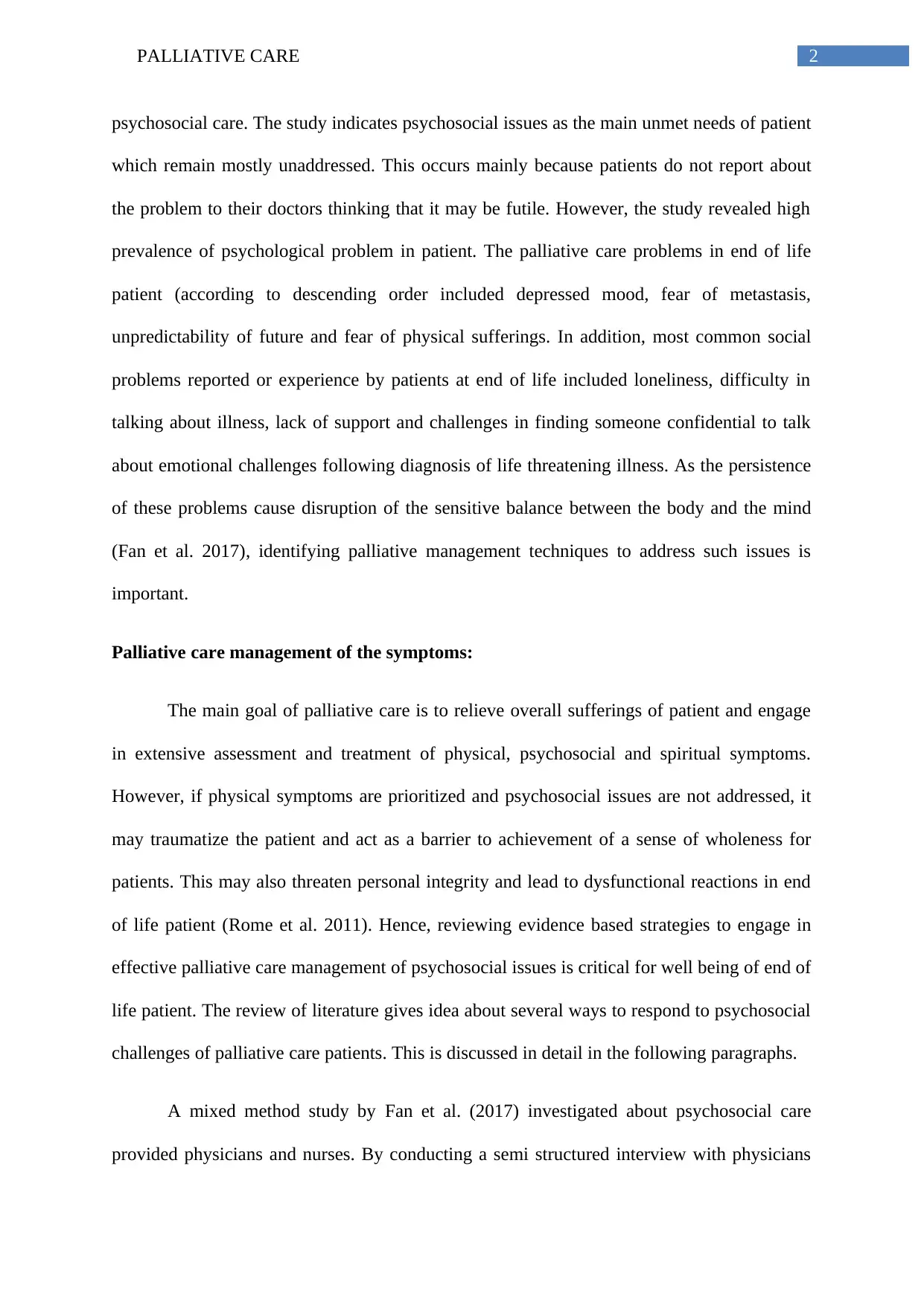
2PALLIATIVE CARE
psychosocial care. The study indicates psychosocial issues as the main unmet needs of patient
which remain mostly unaddressed. This occurs mainly because patients do not report about
the problem to their doctors thinking that it may be futile. However, the study revealed high
prevalence of psychological problem in patient. The palliative care problems in end of life
patient (according to descending order included depressed mood, fear of metastasis,
unpredictability of future and fear of physical sufferings. In addition, most common social
problems reported or experience by patients at end of life included loneliness, difficulty in
talking about illness, lack of support and challenges in finding someone confidential to talk
about emotional challenges following diagnosis of life threatening illness. As the persistence
of these problems cause disruption of the sensitive balance between the body and the mind
(Fan et al. 2017), identifying palliative management techniques to address such issues is
important.
Palliative care management of the symptoms:
The main goal of palliative care is to relieve overall sufferings of patient and engage
in extensive assessment and treatment of physical, psychosocial and spiritual symptoms.
However, if physical symptoms are prioritized and psychosocial issues are not addressed, it
may traumatize the patient and act as a barrier to achievement of a sense of wholeness for
patients. This may also threaten personal integrity and lead to dysfunctional reactions in end
of life patient (Rome et al. 2011). Hence, reviewing evidence based strategies to engage in
effective palliative care management of psychosocial issues is critical for well being of end of
life patient. The review of literature gives idea about several ways to respond to psychosocial
challenges of palliative care patients. This is discussed in detail in the following paragraphs.
A mixed method study by Fan et al. (2017) investigated about psychosocial care
provided physicians and nurses. By conducting a semi structured interview with physicians
psychosocial care. The study indicates psychosocial issues as the main unmet needs of patient
which remain mostly unaddressed. This occurs mainly because patients do not report about
the problem to their doctors thinking that it may be futile. However, the study revealed high
prevalence of psychological problem in patient. The palliative care problems in end of life
patient (according to descending order included depressed mood, fear of metastasis,
unpredictability of future and fear of physical sufferings. In addition, most common social
problems reported or experience by patients at end of life included loneliness, difficulty in
talking about illness, lack of support and challenges in finding someone confidential to talk
about emotional challenges following diagnosis of life threatening illness. As the persistence
of these problems cause disruption of the sensitive balance between the body and the mind
(Fan et al. 2017), identifying palliative management techniques to address such issues is
important.
Palliative care management of the symptoms:
The main goal of palliative care is to relieve overall sufferings of patient and engage
in extensive assessment and treatment of physical, psychosocial and spiritual symptoms.
However, if physical symptoms are prioritized and psychosocial issues are not addressed, it
may traumatize the patient and act as a barrier to achievement of a sense of wholeness for
patients. This may also threaten personal integrity and lead to dysfunctional reactions in end
of life patient (Rome et al. 2011). Hence, reviewing evidence based strategies to engage in
effective palliative care management of psychosocial issues is critical for well being of end of
life patient. The review of literature gives idea about several ways to respond to psychosocial
challenges of palliative care patients. This is discussed in detail in the following paragraphs.
A mixed method study by Fan et al. (2017) investigated about psychosocial care
provided physicians and nurses. By conducting a semi structured interview with physicians
⊘ This is a preview!⊘
Do you want full access?
Subscribe today to unlock all pages.

Trusted by 1+ million students worldwide
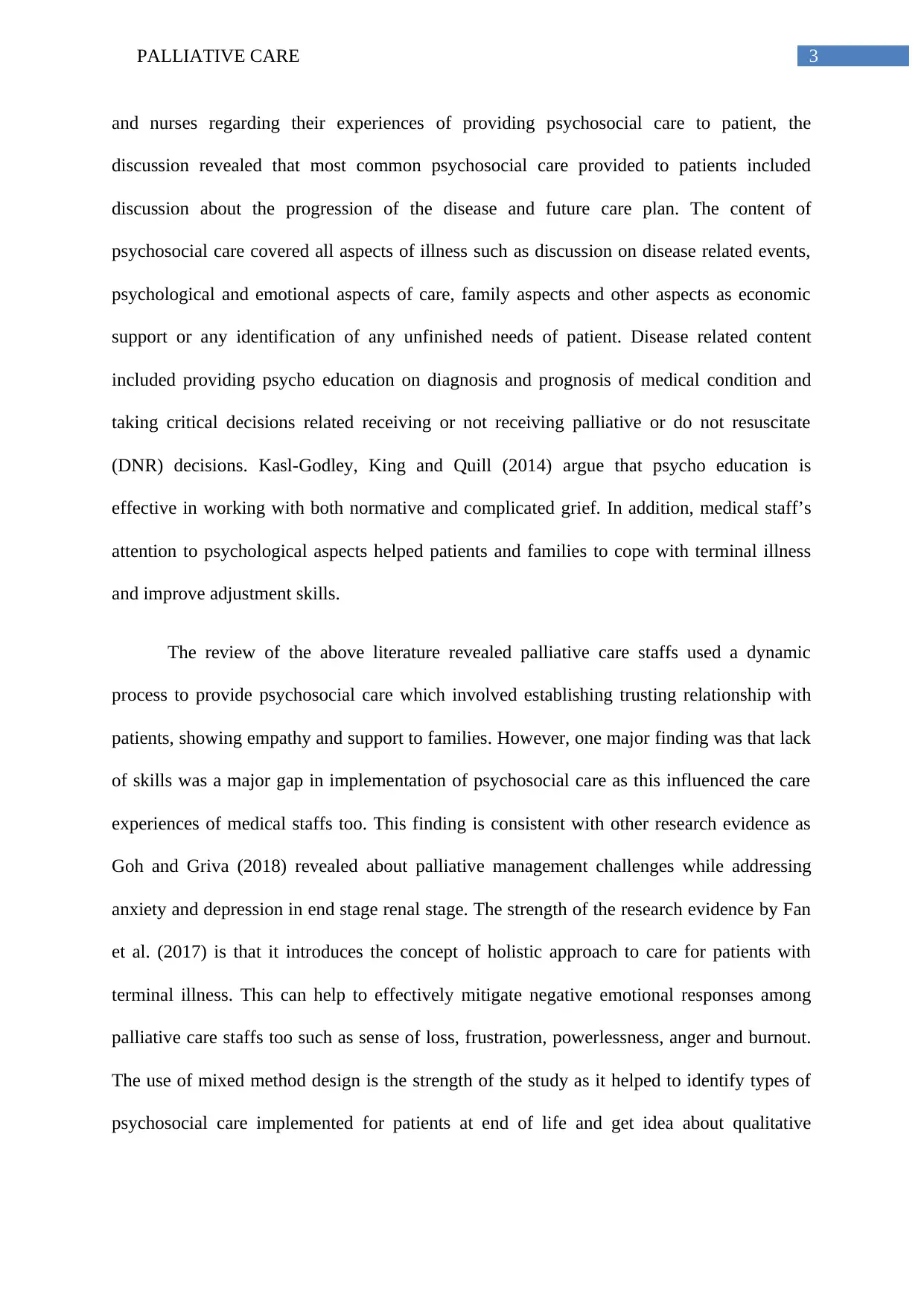
3PALLIATIVE CARE
and nurses regarding their experiences of providing psychosocial care to patient, the
discussion revealed that most common psychosocial care provided to patients included
discussion about the progression of the disease and future care plan. The content of
psychosocial care covered all aspects of illness such as discussion on disease related events,
psychological and emotional aspects of care, family aspects and other aspects as economic
support or any identification of any unfinished needs of patient. Disease related content
included providing psycho education on diagnosis and prognosis of medical condition and
taking critical decisions related receiving or not receiving palliative or do not resuscitate
(DNR) decisions. Kasl-Godley, King and Quill (2014) argue that psycho education is
effective in working with both normative and complicated grief. In addition, medical staff’s
attention to psychological aspects helped patients and families to cope with terminal illness
and improve adjustment skills.
The review of the above literature revealed palliative care staffs used a dynamic
process to provide psychosocial care which involved establishing trusting relationship with
patients, showing empathy and support to families. However, one major finding was that lack
of skills was a major gap in implementation of psychosocial care as this influenced the care
experiences of medical staffs too. This finding is consistent with other research evidence as
Goh and Griva (2018) revealed about palliative management challenges while addressing
anxiety and depression in end stage renal stage. The strength of the research evidence by Fan
et al. (2017) is that it introduces the concept of holistic approach to care for patients with
terminal illness. This can help to effectively mitigate negative emotional responses among
palliative care staffs too such as sense of loss, frustration, powerlessness, anger and burnout.
The use of mixed method design is the strength of the study as it helped to identify types of
psychosocial care implemented for patients at end of life and get idea about qualitative
and nurses regarding their experiences of providing psychosocial care to patient, the
discussion revealed that most common psychosocial care provided to patients included
discussion about the progression of the disease and future care plan. The content of
psychosocial care covered all aspects of illness such as discussion on disease related events,
psychological and emotional aspects of care, family aspects and other aspects as economic
support or any identification of any unfinished needs of patient. Disease related content
included providing psycho education on diagnosis and prognosis of medical condition and
taking critical decisions related receiving or not receiving palliative or do not resuscitate
(DNR) decisions. Kasl-Godley, King and Quill (2014) argue that psycho education is
effective in working with both normative and complicated grief. In addition, medical staff’s
attention to psychological aspects helped patients and families to cope with terminal illness
and improve adjustment skills.
The review of the above literature revealed palliative care staffs used a dynamic
process to provide psychosocial care which involved establishing trusting relationship with
patients, showing empathy and support to families. However, one major finding was that lack
of skills was a major gap in implementation of psychosocial care as this influenced the care
experiences of medical staffs too. This finding is consistent with other research evidence as
Goh and Griva (2018) revealed about palliative management challenges while addressing
anxiety and depression in end stage renal stage. The strength of the research evidence by Fan
et al. (2017) is that it introduces the concept of holistic approach to care for patients with
terminal illness. This can help to effectively mitigate negative emotional responses among
palliative care staffs too such as sense of loss, frustration, powerlessness, anger and burnout.
The use of mixed method design is the strength of the study as it helped to identify types of
psychosocial care implemented for patients at end of life and get idea about qualitative
Paraphrase This Document
Need a fresh take? Get an instant paraphrase of this document with our AI Paraphraser
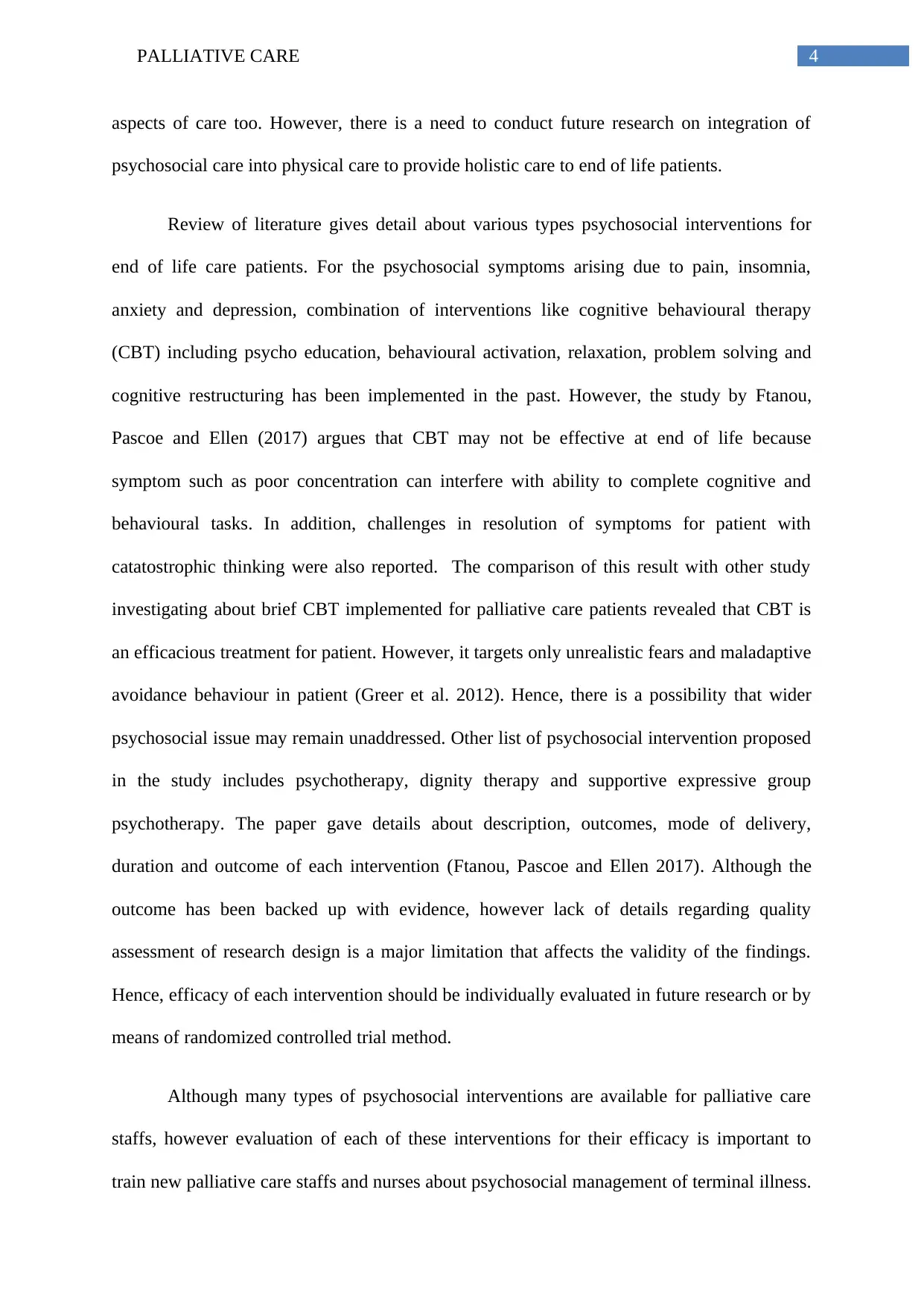
4PALLIATIVE CARE
aspects of care too. However, there is a need to conduct future research on integration of
psychosocial care into physical care to provide holistic care to end of life patients.
Review of literature gives detail about various types psychosocial interventions for
end of life care patients. For the psychosocial symptoms arising due to pain, insomnia,
anxiety and depression, combination of interventions like cognitive behavioural therapy
(CBT) including psycho education, behavioural activation, relaxation, problem solving and
cognitive restructuring has been implemented in the past. However, the study by Ftanou,
Pascoe and Ellen (2017) argues that CBT may not be effective at end of life because
symptom such as poor concentration can interfere with ability to complete cognitive and
behavioural tasks. In addition, challenges in resolution of symptoms for patient with
catatostrophic thinking were also reported. The comparison of this result with other study
investigating about brief CBT implemented for palliative care patients revealed that CBT is
an efficacious treatment for patient. However, it targets only unrealistic fears and maladaptive
avoidance behaviour in patient (Greer et al. 2012). Hence, there is a possibility that wider
psychosocial issue may remain unaddressed. Other list of psychosocial intervention proposed
in the study includes psychotherapy, dignity therapy and supportive expressive group
psychotherapy. The paper gave details about description, outcomes, mode of delivery,
duration and outcome of each intervention (Ftanou, Pascoe and Ellen 2017). Although the
outcome has been backed up with evidence, however lack of details regarding quality
assessment of research design is a major limitation that affects the validity of the findings.
Hence, efficacy of each intervention should be individually evaluated in future research or by
means of randomized controlled trial method.
Although many types of psychosocial interventions are available for palliative care
staffs, however evaluation of each of these interventions for their efficacy is important to
train new palliative care staffs and nurses about psychosocial management of terminal illness.
aspects of care too. However, there is a need to conduct future research on integration of
psychosocial care into physical care to provide holistic care to end of life patients.
Review of literature gives detail about various types psychosocial interventions for
end of life care patients. For the psychosocial symptoms arising due to pain, insomnia,
anxiety and depression, combination of interventions like cognitive behavioural therapy
(CBT) including psycho education, behavioural activation, relaxation, problem solving and
cognitive restructuring has been implemented in the past. However, the study by Ftanou,
Pascoe and Ellen (2017) argues that CBT may not be effective at end of life because
symptom such as poor concentration can interfere with ability to complete cognitive and
behavioural tasks. In addition, challenges in resolution of symptoms for patient with
catatostrophic thinking were also reported. The comparison of this result with other study
investigating about brief CBT implemented for palliative care patients revealed that CBT is
an efficacious treatment for patient. However, it targets only unrealistic fears and maladaptive
avoidance behaviour in patient (Greer et al. 2012). Hence, there is a possibility that wider
psychosocial issue may remain unaddressed. Other list of psychosocial intervention proposed
in the study includes psychotherapy, dignity therapy and supportive expressive group
psychotherapy. The paper gave details about description, outcomes, mode of delivery,
duration and outcome of each intervention (Ftanou, Pascoe and Ellen 2017). Although the
outcome has been backed up with evidence, however lack of details regarding quality
assessment of research design is a major limitation that affects the validity of the findings.
Hence, efficacy of each intervention should be individually evaluated in future research or by
means of randomized controlled trial method.
Although many types of psychosocial interventions are available for palliative care
staffs, however evaluation of each of these interventions for their efficacy is important to
train new palliative care staffs and nurses about psychosocial management of terminal illness.
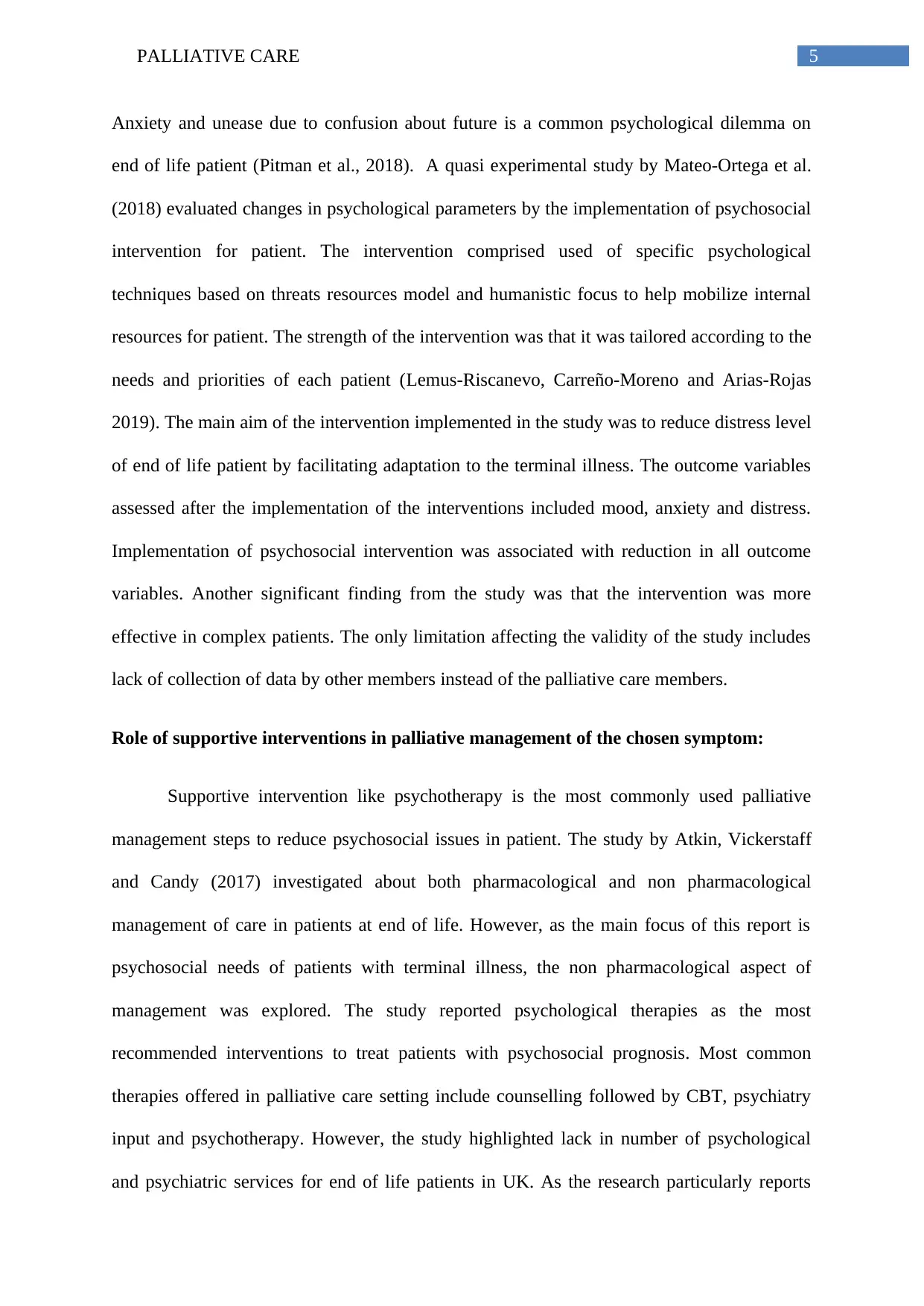
5PALLIATIVE CARE
Anxiety and unease due to confusion about future is a common psychological dilemma on
end of life patient (Pitman et al., 2018). A quasi experimental study by Mateo-Ortega et al.
(2018) evaluated changes in psychological parameters by the implementation of psychosocial
intervention for patient. The intervention comprised used of specific psychological
techniques based on threats resources model and humanistic focus to help mobilize internal
resources for patient. The strength of the intervention was that it was tailored according to the
needs and priorities of each patient (Lemus-Riscanevo, Carreño-Moreno and Arias-Rojas
2019). The main aim of the intervention implemented in the study was to reduce distress level
of end of life patient by facilitating adaptation to the terminal illness. The outcome variables
assessed after the implementation of the interventions included mood, anxiety and distress.
Implementation of psychosocial intervention was associated with reduction in all outcome
variables. Another significant finding from the study was that the intervention was more
effective in complex patients. The only limitation affecting the validity of the study includes
lack of collection of data by other members instead of the palliative care members.
Role of supportive interventions in palliative management of the chosen symptom:
Supportive intervention like psychotherapy is the most commonly used palliative
management steps to reduce psychosocial issues in patient. The study by Atkin, Vickerstaff
and Candy (2017) investigated about both pharmacological and non pharmacological
management of care in patients at end of life. However, as the main focus of this report is
psychosocial needs of patients with terminal illness, the non pharmacological aspect of
management was explored. The study reported psychological therapies as the most
recommended interventions to treat patients with psychosocial prognosis. Most common
therapies offered in palliative care setting include counselling followed by CBT, psychiatry
input and psychotherapy. However, the study highlighted lack in number of psychological
and psychiatric services for end of life patients in UK. As the research particularly reports
Anxiety and unease due to confusion about future is a common psychological dilemma on
end of life patient (Pitman et al., 2018). A quasi experimental study by Mateo-Ortega et al.
(2018) evaluated changes in psychological parameters by the implementation of psychosocial
intervention for patient. The intervention comprised used of specific psychological
techniques based on threats resources model and humanistic focus to help mobilize internal
resources for patient. The strength of the intervention was that it was tailored according to the
needs and priorities of each patient (Lemus-Riscanevo, Carreño-Moreno and Arias-Rojas
2019). The main aim of the intervention implemented in the study was to reduce distress level
of end of life patient by facilitating adaptation to the terminal illness. The outcome variables
assessed after the implementation of the interventions included mood, anxiety and distress.
Implementation of psychosocial intervention was associated with reduction in all outcome
variables. Another significant finding from the study was that the intervention was more
effective in complex patients. The only limitation affecting the validity of the study includes
lack of collection of data by other members instead of the palliative care members.
Role of supportive interventions in palliative management of the chosen symptom:
Supportive intervention like psychotherapy is the most commonly used palliative
management steps to reduce psychosocial issues in patient. The study by Atkin, Vickerstaff
and Candy (2017) investigated about both pharmacological and non pharmacological
management of care in patients at end of life. However, as the main focus of this report is
psychosocial needs of patients with terminal illness, the non pharmacological aspect of
management was explored. The study reported psychological therapies as the most
recommended interventions to treat patients with psychosocial prognosis. Most common
therapies offered in palliative care setting include counselling followed by CBT, psychiatry
input and psychotherapy. However, the study highlighted lack in number of psychological
and psychiatric services for end of life patients in UK. As the research particularly reports
⊘ This is a preview!⊘
Do you want full access?
Subscribe today to unlock all pages.

Trusted by 1+ million students worldwide
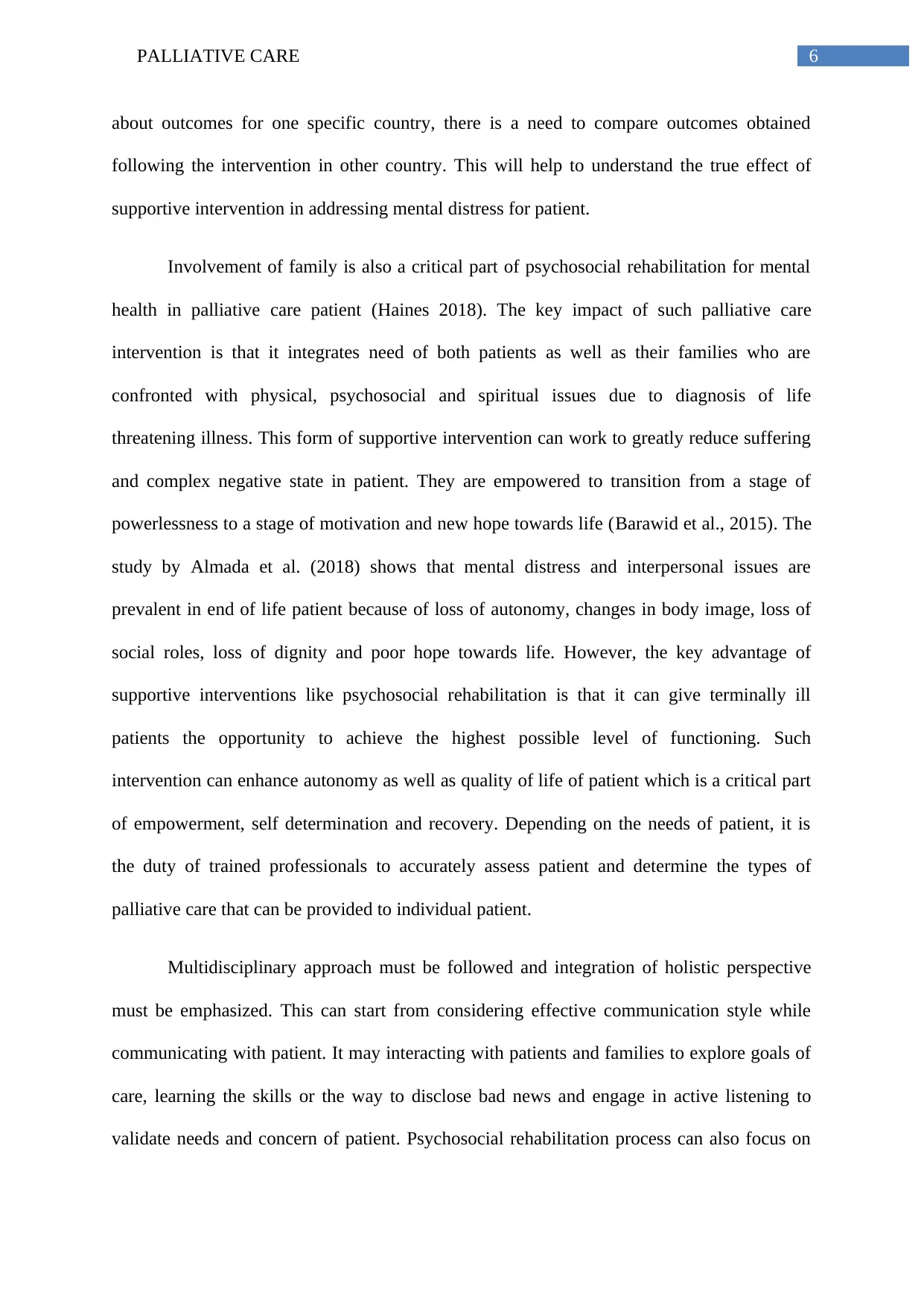
6PALLIATIVE CARE
about outcomes for one specific country, there is a need to compare outcomes obtained
following the intervention in other country. This will help to understand the true effect of
supportive intervention in addressing mental distress for patient.
Involvement of family is also a critical part of psychosocial rehabilitation for mental
health in palliative care patient (Haines 2018). The key impact of such palliative care
intervention is that it integrates need of both patients as well as their families who are
confronted with physical, psychosocial and spiritual issues due to diagnosis of life
threatening illness. This form of supportive intervention can work to greatly reduce suffering
and complex negative state in patient. They are empowered to transition from a stage of
powerlessness to a stage of motivation and new hope towards life (Barawid et al., 2015). The
study by Almada et al. (2018) shows that mental distress and interpersonal issues are
prevalent in end of life patient because of loss of autonomy, changes in body image, loss of
social roles, loss of dignity and poor hope towards life. However, the key advantage of
supportive interventions like psychosocial rehabilitation is that it can give terminally ill
patients the opportunity to achieve the highest possible level of functioning. Such
intervention can enhance autonomy as well as quality of life of patient which is a critical part
of empowerment, self determination and recovery. Depending on the needs of patient, it is
the duty of trained professionals to accurately assess patient and determine the types of
palliative care that can be provided to individual patient.
Multidisciplinary approach must be followed and integration of holistic perspective
must be emphasized. This can start from considering effective communication style while
communicating with patient. It may interacting with patients and families to explore goals of
care, learning the skills or the way to disclose bad news and engage in active listening to
validate needs and concern of patient. Psychosocial rehabilitation process can also focus on
about outcomes for one specific country, there is a need to compare outcomes obtained
following the intervention in other country. This will help to understand the true effect of
supportive intervention in addressing mental distress for patient.
Involvement of family is also a critical part of psychosocial rehabilitation for mental
health in palliative care patient (Haines 2018). The key impact of such palliative care
intervention is that it integrates need of both patients as well as their families who are
confronted with physical, psychosocial and spiritual issues due to diagnosis of life
threatening illness. This form of supportive intervention can work to greatly reduce suffering
and complex negative state in patient. They are empowered to transition from a stage of
powerlessness to a stage of motivation and new hope towards life (Barawid et al., 2015). The
study by Almada et al. (2018) shows that mental distress and interpersonal issues are
prevalent in end of life patient because of loss of autonomy, changes in body image, loss of
social roles, loss of dignity and poor hope towards life. However, the key advantage of
supportive interventions like psychosocial rehabilitation is that it can give terminally ill
patients the opportunity to achieve the highest possible level of functioning. Such
intervention can enhance autonomy as well as quality of life of patient which is a critical part
of empowerment, self determination and recovery. Depending on the needs of patient, it is
the duty of trained professionals to accurately assess patient and determine the types of
palliative care that can be provided to individual patient.
Multidisciplinary approach must be followed and integration of holistic perspective
must be emphasized. This can start from considering effective communication style while
communicating with patient. It may interacting with patients and families to explore goals of
care, learning the skills or the way to disclose bad news and engage in active listening to
validate needs and concern of patient. Psychosocial rehabilitation process can also focus on
Paraphrase This Document
Need a fresh take? Get an instant paraphrase of this document with our AI Paraphraser
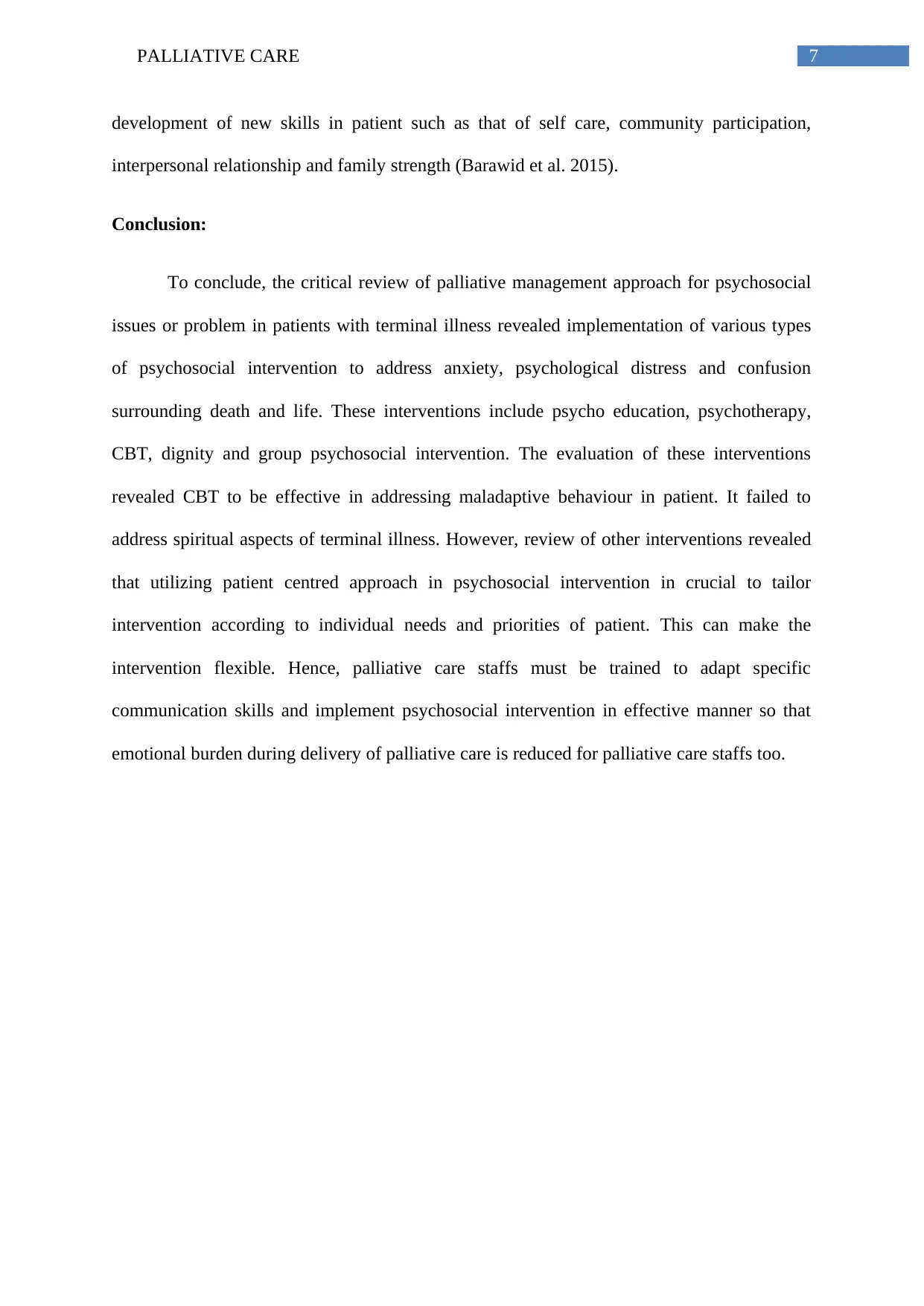
7PALLIATIVE CARE
development of new skills in patient such as that of self care, community participation,
interpersonal relationship and family strength (Barawid et al. 2015).
Conclusion:
To conclude, the critical review of palliative management approach for psychosocial
issues or problem in patients with terminal illness revealed implementation of various types
of psychosocial intervention to address anxiety, psychological distress and confusion
surrounding death and life. These interventions include psycho education, psychotherapy,
CBT, dignity and group psychosocial intervention. The evaluation of these interventions
revealed CBT to be effective in addressing maladaptive behaviour in patient. It failed to
address spiritual aspects of terminal illness. However, review of other interventions revealed
that utilizing patient centred approach in psychosocial intervention in crucial to tailor
intervention according to individual needs and priorities of patient. This can make the
intervention flexible. Hence, palliative care staffs must be trained to adapt specific
communication skills and implement psychosocial intervention in effective manner so that
emotional burden during delivery of palliative care is reduced for palliative care staffs too.
development of new skills in patient such as that of self care, community participation,
interpersonal relationship and family strength (Barawid et al. 2015).
Conclusion:
To conclude, the critical review of palliative management approach for psychosocial
issues or problem in patients with terminal illness revealed implementation of various types
of psychosocial intervention to address anxiety, psychological distress and confusion
surrounding death and life. These interventions include psycho education, psychotherapy,
CBT, dignity and group psychosocial intervention. The evaluation of these interventions
revealed CBT to be effective in addressing maladaptive behaviour in patient. It failed to
address spiritual aspects of terminal illness. However, review of other interventions revealed
that utilizing patient centred approach in psychosocial intervention in crucial to tailor
intervention according to individual needs and priorities of patient. This can make the
intervention flexible. Hence, palliative care staffs must be trained to adapt specific
communication skills and implement psychosocial intervention in effective manner so that
emotional burden during delivery of palliative care is reduced for palliative care staffs too.
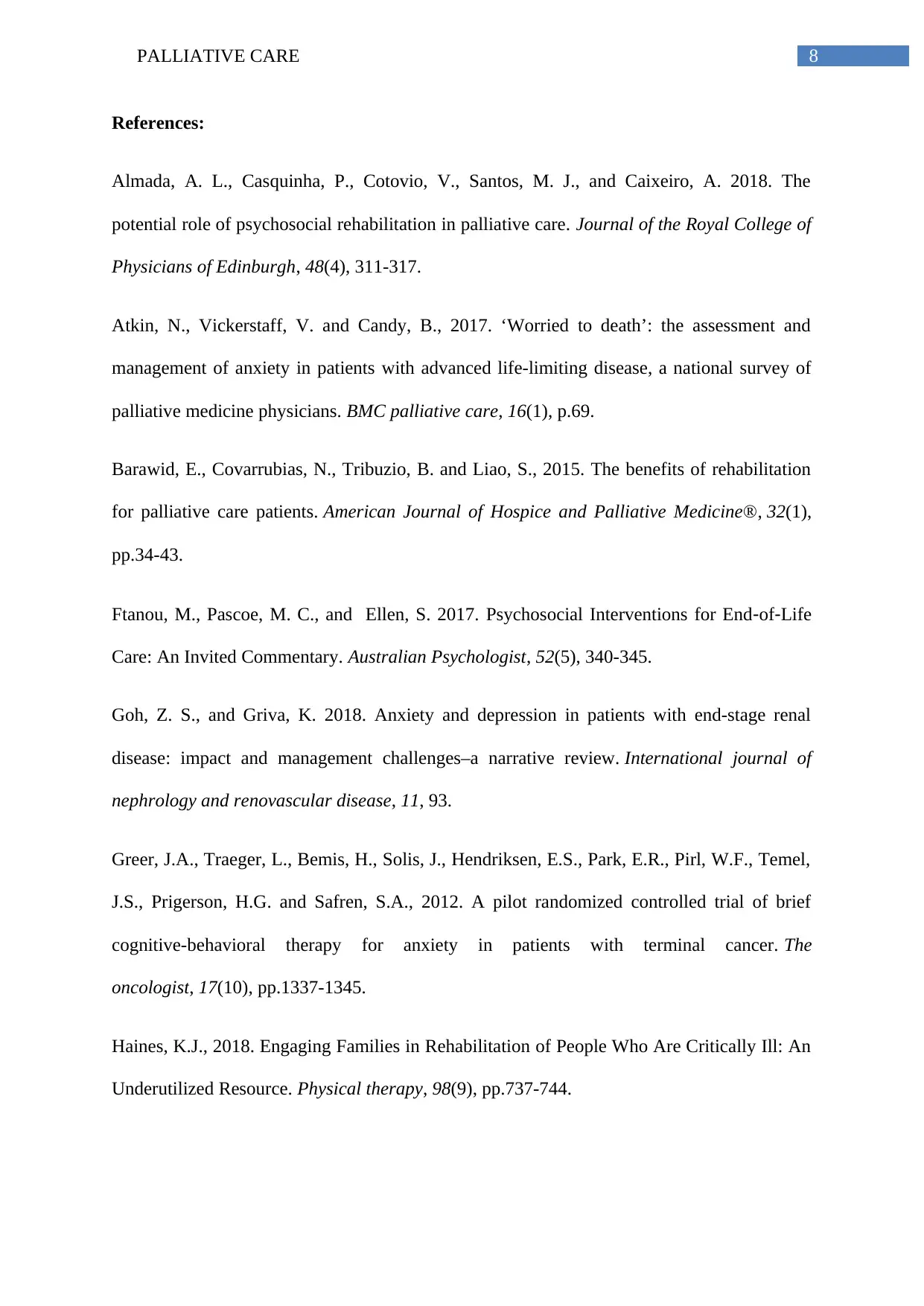
8PALLIATIVE CARE
References:
Almada, A. L., Casquinha, P., Cotovio, V., Santos, M. J., and Caixeiro, A. 2018. The
potential role of psychosocial rehabilitation in palliative care. Journal of the Royal College of
Physicians of Edinburgh, 48(4), 311-317.
Atkin, N., Vickerstaff, V. and Candy, B., 2017. ‘Worried to death’: the assessment and
management of anxiety in patients with advanced life-limiting disease, a national survey of
palliative medicine physicians. BMC palliative care, 16(1), p.69.
Barawid, E., Covarrubias, N., Tribuzio, B. and Liao, S., 2015. The benefits of rehabilitation
for palliative care patients. American Journal of Hospice and Palliative Medicine®, 32(1),
pp.34-43.
Ftanou, M., Pascoe, M. C., and Ellen, S. 2017. Psychosocial Interventions for End‐of‐Life
Care: An Invited Commentary. Australian Psychologist, 52(5), 340-345.
Goh, Z. S., and Griva, K. 2018. Anxiety and depression in patients with end-stage renal
disease: impact and management challenges–a narrative review. International journal of
nephrology and renovascular disease, 11, 93.
Greer, J.A., Traeger, L., Bemis, H., Solis, J., Hendriksen, E.S., Park, E.R., Pirl, W.F., Temel,
J.S., Prigerson, H.G. and Safren, S.A., 2012. A pilot randomized controlled trial of brief
cognitive-behavioral therapy for anxiety in patients with terminal cancer. The
oncologist, 17(10), pp.1337-1345.
Haines, K.J., 2018. Engaging Families in Rehabilitation of People Who Are Critically Ill: An
Underutilized Resource. Physical therapy, 98(9), pp.737-744.
References:
Almada, A. L., Casquinha, P., Cotovio, V., Santos, M. J., and Caixeiro, A. 2018. The
potential role of psychosocial rehabilitation in palliative care. Journal of the Royal College of
Physicians of Edinburgh, 48(4), 311-317.
Atkin, N., Vickerstaff, V. and Candy, B., 2017. ‘Worried to death’: the assessment and
management of anxiety in patients with advanced life-limiting disease, a national survey of
palliative medicine physicians. BMC palliative care, 16(1), p.69.
Barawid, E., Covarrubias, N., Tribuzio, B. and Liao, S., 2015. The benefits of rehabilitation
for palliative care patients. American Journal of Hospice and Palliative Medicine®, 32(1),
pp.34-43.
Ftanou, M., Pascoe, M. C., and Ellen, S. 2017. Psychosocial Interventions for End‐of‐Life
Care: An Invited Commentary. Australian Psychologist, 52(5), 340-345.
Goh, Z. S., and Griva, K. 2018. Anxiety and depression in patients with end-stage renal
disease: impact and management challenges–a narrative review. International journal of
nephrology and renovascular disease, 11, 93.
Greer, J.A., Traeger, L., Bemis, H., Solis, J., Hendriksen, E.S., Park, E.R., Pirl, W.F., Temel,
J.S., Prigerson, H.G. and Safren, S.A., 2012. A pilot randomized controlled trial of brief
cognitive-behavioral therapy for anxiety in patients with terminal cancer. The
oncologist, 17(10), pp.1337-1345.
Haines, K.J., 2018. Engaging Families in Rehabilitation of People Who Are Critically Ill: An
Underutilized Resource. Physical therapy, 98(9), pp.737-744.
⊘ This is a preview!⊘
Do you want full access?
Subscribe today to unlock all pages.

Trusted by 1+ million students worldwide
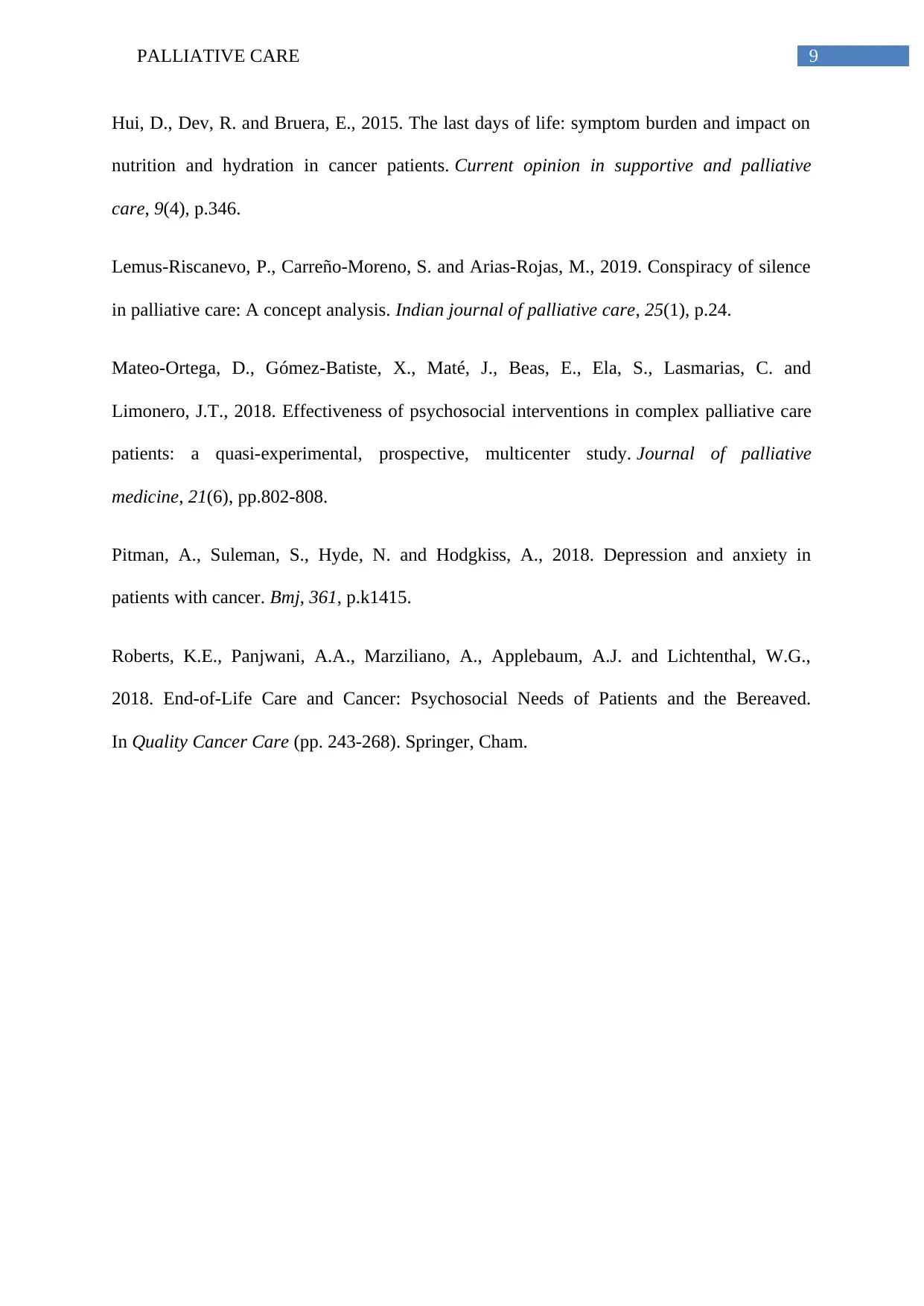
9PALLIATIVE CARE
Hui, D., Dev, R. and Bruera, E., 2015. The last days of life: symptom burden and impact on
nutrition and hydration in cancer patients. Current opinion in supportive and palliative
care, 9(4), p.346.
Lemus-Riscanevo, P., Carreño-Moreno, S. and Arias-Rojas, M., 2019. Conspiracy of silence
in palliative care: A concept analysis. Indian journal of palliative care, 25(1), p.24.
Mateo-Ortega, D., Gómez-Batiste, X., Maté, J., Beas, E., Ela, S., Lasmarias, C. and
Limonero, J.T., 2018. Effectiveness of psychosocial interventions in complex palliative care
patients: a quasi-experimental, prospective, multicenter study. Journal of palliative
medicine, 21(6), pp.802-808.
Pitman, A., Suleman, S., Hyde, N. and Hodgkiss, A., 2018. Depression and anxiety in
patients with cancer. Bmj, 361, p.k1415.
Roberts, K.E., Panjwani, A.A., Marziliano, A., Applebaum, A.J. and Lichtenthal, W.G.,
2018. End-of-Life Care and Cancer: Psychosocial Needs of Patients and the Bereaved.
In Quality Cancer Care (pp. 243-268). Springer, Cham.
Hui, D., Dev, R. and Bruera, E., 2015. The last days of life: symptom burden and impact on
nutrition and hydration in cancer patients. Current opinion in supportive and palliative
care, 9(4), p.346.
Lemus-Riscanevo, P., Carreño-Moreno, S. and Arias-Rojas, M., 2019. Conspiracy of silence
in palliative care: A concept analysis. Indian journal of palliative care, 25(1), p.24.
Mateo-Ortega, D., Gómez-Batiste, X., Maté, J., Beas, E., Ela, S., Lasmarias, C. and
Limonero, J.T., 2018. Effectiveness of psychosocial interventions in complex palliative care
patients: a quasi-experimental, prospective, multicenter study. Journal of palliative
medicine, 21(6), pp.802-808.
Pitman, A., Suleman, S., Hyde, N. and Hodgkiss, A., 2018. Depression and anxiety in
patients with cancer. Bmj, 361, p.k1415.
Roberts, K.E., Panjwani, A.A., Marziliano, A., Applebaum, A.J. and Lichtenthal, W.G.,
2018. End-of-Life Care and Cancer: Psychosocial Needs of Patients and the Bereaved.
In Quality Cancer Care (pp. 243-268). Springer, Cham.
1 out of 10
Related Documents
Your All-in-One AI-Powered Toolkit for Academic Success.
+13062052269
info@desklib.com
Available 24*7 on WhatsApp / Email
![[object Object]](/_next/static/media/star-bottom.7253800d.svg)
Unlock your academic potential
Copyright © 2020–2025 A2Z Services. All Rights Reserved. Developed and managed by ZUCOL.





